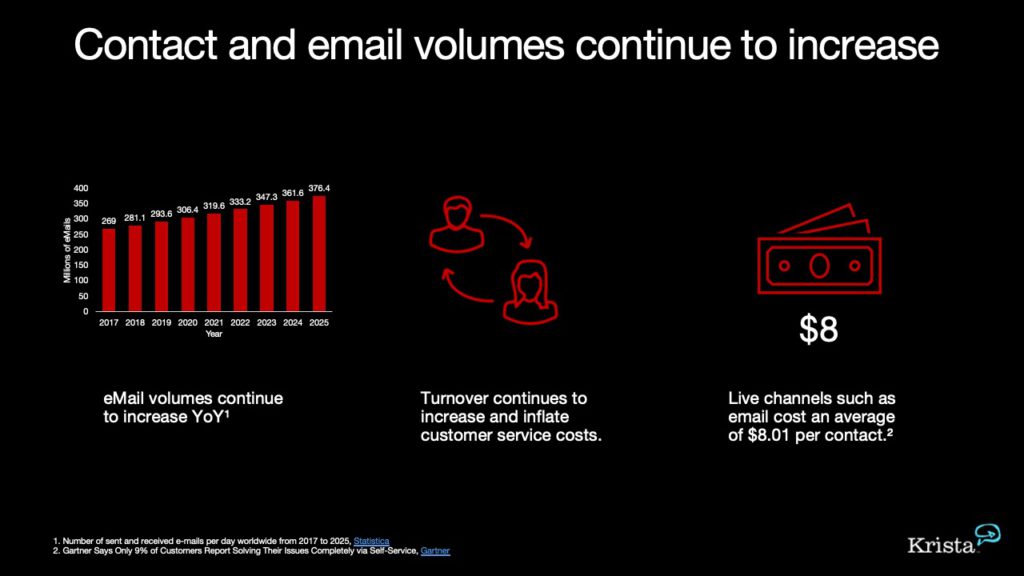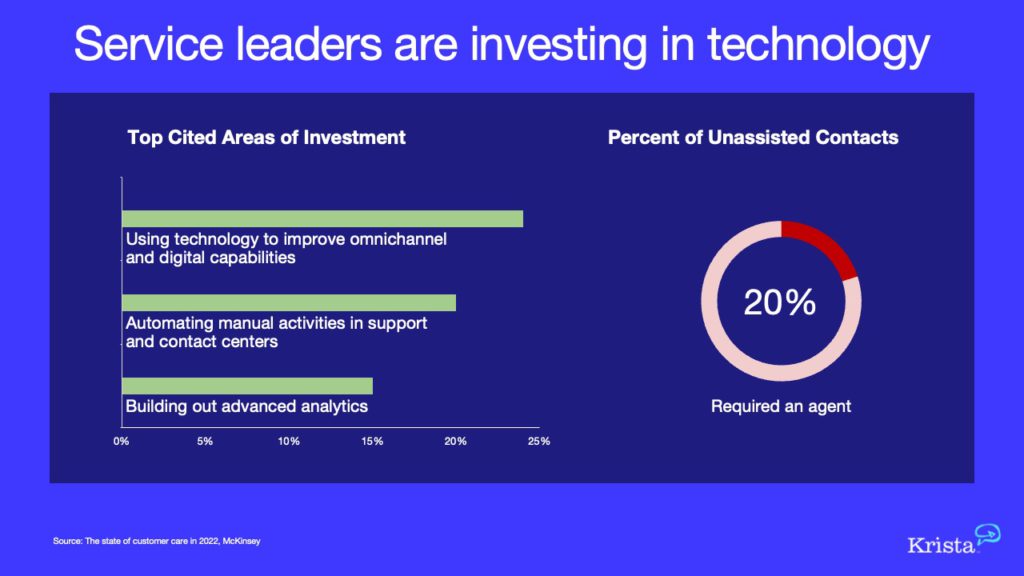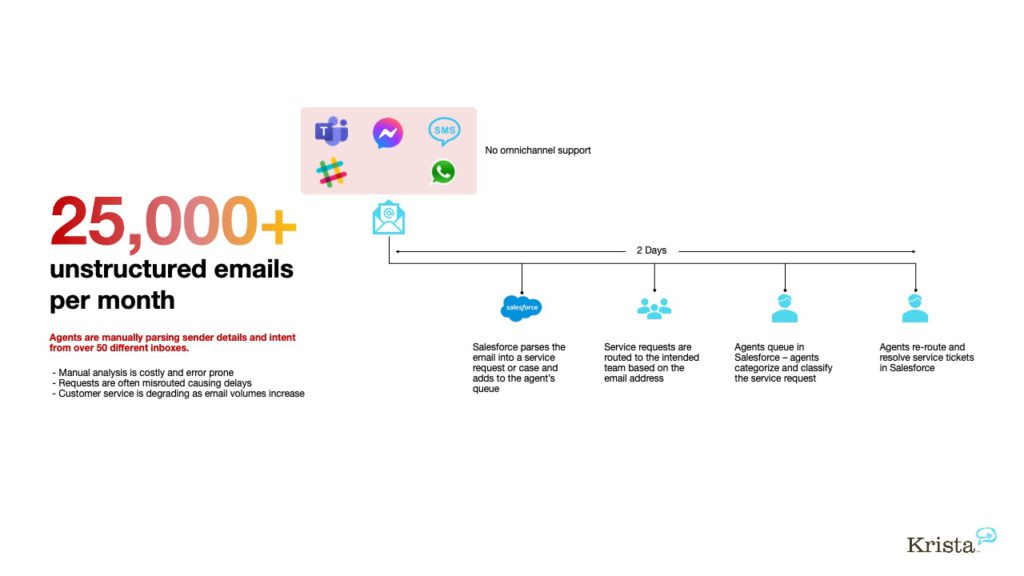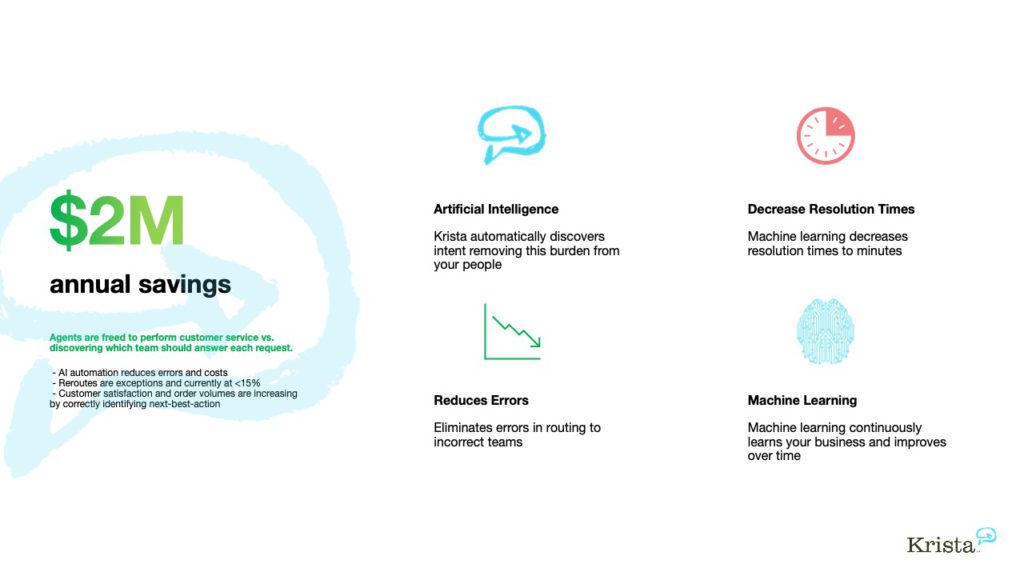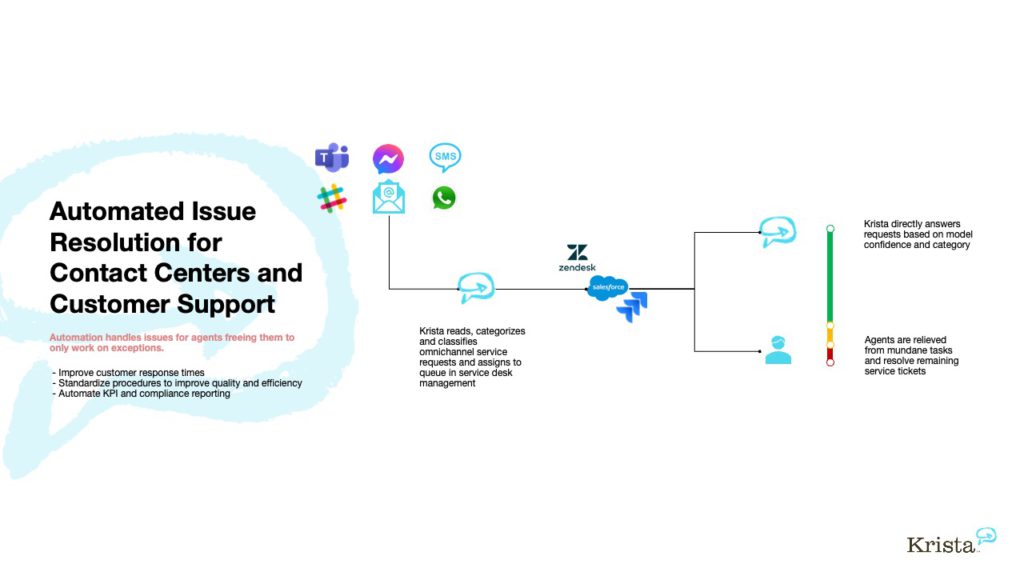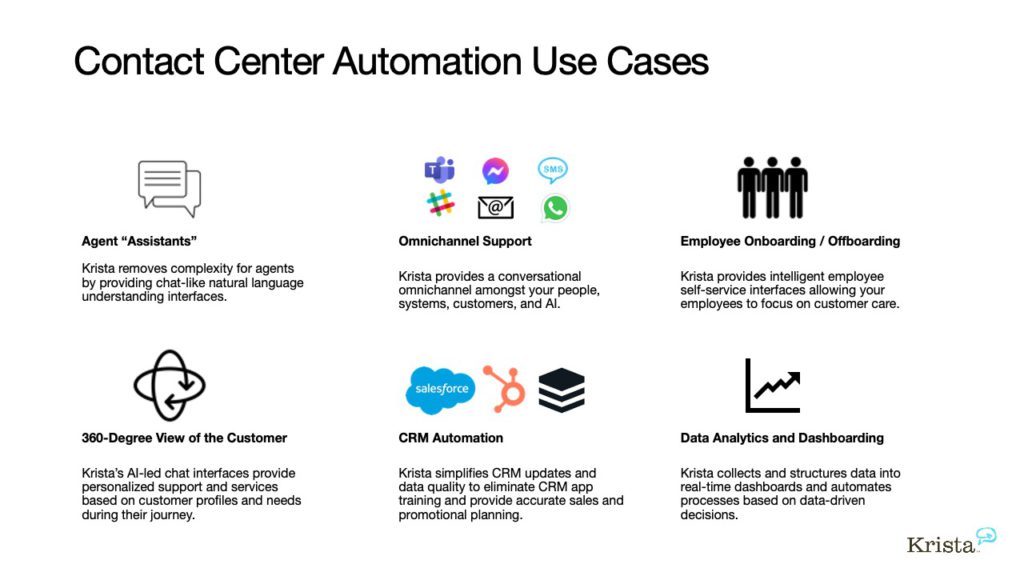Contact centers are overworked and seeking more automation
Contact centers and customer support organizations are increasingly constrained as more business moves to omnichannel. Email and omnichannel message volumes increase YoY and overwhelm the staff. High turnover rates cause organizations to constantly train new and existing employees on how to appropriately respond to increasingly complex customer issues.
Service leaders are investing in technology
Your contact centers and customer support organizations are responsible for improving customer satisfaction levels and loyalty at lower operating costs. In order to do this, they have to find ways to improve their agents’ productivity and performance so they only work on the most important tasks. This means leveraging AI tools like a virtual assistant or generative AI to move relevant actions to digital self-service channels. By providing better customer experiences across the omnichannel, they can remove the need to solve each issue with a manual touchpoint and automate more work.
However, these efforts are producing slower than expected results because of complex integrations and custom solutions. According to McKinsey’s Customer Care Survey1 amongst 160 senior industry leaders and experts, only 12 percent of digital platforms are highly integrated, and most organizations state only 20 percent of digital contacts are resolved unassisted.
According to Gartner2, only 9% of customers report being able to completely solve their issues via a digital self-service channel. Gartner further states solving customer issues via live channels such as phone, live chat and email cost an average of $8.01 per contact, while self-service channels cost about $0.10 per contact.
Customer support organizations need to implement an email bot and a chatbot using AI that adapts to each customer’s intent and provides a smart reply each time.
Contact centers are “slightly” automated
Ask a contact center leader if they have automation and most will state they do. According to the aforementioned report from McKinsey, 77 percent of customer care professionals answered they have automated digital platforms. But not all automation is equal. Only 10 percent state customers are fully utilizing the newer digital channels. There is significant room for improvement.
For example, a nationwide B2B supplier has an automated service desk management solution to manage incoming emails. This supplier receives tens of thousands of emails per month for various customer service issues like billing, change orders, lost items, and 50 other categories. However, even though the process is automated, it still contained manual work to discover intent in customer emails and to correctly assign each task.
Many times customers would email an incorrect inbox and therefore notify the wrong department. Once the assigned team found the email classification was incorrect, they would need to manually edit the ticket to route it to the correct team. A customer with an order dispute would email billing@thecompany.com or send a request to customerservice@thecompany.com for damaged goods. Both of these situations caused delays since the customer emailed the wrong department. Therefore, agents had to read each email to discover the customer’s intent and reroute to the correct department to handle the dispute. Many times it took so long that the customer sent a second or third email causing more noise and duplicate tickets.
How to use AI to discover intent and automatically respond to email
Customer service organizations and contact centers must find a better way to quickly respond to customer requests without manual intervention. One way to do this is by using machine learning (ML) and natural language processing (NLP) to read incoming emails and messages and quickly formulate smart replies to each based on context. Using an email bot can help businesses improve customer satisfaction and reduce operational costs by automating intent discovery and routing to service more clients in less time.
Krista AI Automatically Discovers Intent and Solves Customers’ Issues
Companies are automating email and omnichannel responses with Krista. Automating responses with Krista not only improves customer satisfaction but also reduces operational costs.
Krista is an artificial intelligence software that reads and responds to customer service requests. Krista uses natural language understanding (NLU) to read emails and messages to discover the customer’s intent. Krista is an email assistant that can automatically respond to requests like billing or shipment questions and can escalate more complex disputes to the correct customer service representative. The nationwide B2B supplier I mentioned above saved over 2 million dollars per year by redirecting labor from agents to Krista. Krista now answers emails she is trained on and routes exceptions to the correct service team based on the customer’s intent. Thanks to Krista, this company provides better, more timely service to its customers at a fraction of the cost. The savings will only continue to grow, and the company plans to reinvest what it learned to find more opportunities to automate processes outside of customer service.
How to set up your own AI email responder for your service desk
If you’re looking to set up your own AI email responder for your service desk, there are a few things you’ll need to do.
1. Connect your email inboxes and/or service desk management software to Krista.
If you want Krista to look up information in other systems like order management, ERP, or human resources, you can connect them with readily available Krista Connectors. Krista Connectors are available in the public catalog.
2. Train Krista on responses
Train Krista on responses. If you have historical emails and responses, you can use this data to train Krista on email classification. If not, Krista will build a machine learning model for you as questions come in and responses are recorded.
3. Monitor email assistant
Once trained, Krista can respond when a customer sends an email or message, Krista uses NLP to read and analyze the text to discover intent. Based on the customer’s intent, Krista will either respond automatically or route the message to the correct customer service team based on the data in the message. For example, if a customer sends an email asking about a billing issue, Krista will automatically generate a response for the next best action.
4. Report progress
Krista logs each request, any notes, and resolutions in your service desk management software and updates her machine learning model. Your current service desk management software can remain for reporting and compliance. There isn’t a need to remove it since Krista can integrate with your systems and read and write data if appropriate.
5. Expand automation
Sit back and watch Krista improve your customer service scores and reduce your operating costs. Using an email bot to quickly answer mails not only provides a great customer experience, it also improves employee morale and achievement by moving on to more important work rather than constantly look up data in a database.
Other contact center processes you can automate.
AI Assistants Using Generative AI:
Generative AI like ChatGPT from OpenAI, and Bard from Google are great for generating better emails for smart replies, but they need the right prompts. Krista integrates your systems, agents, and generative AI to automate entire workflows. Using Krista AI integration platform as as service (AI iPaaS) enables your subject matter experts to easily build workflows originating from email or chat.
Automate omnichannel responses:
You can automate responses to incoming messages with machine learning. When customers message your contact center, an AI tool using natural language processing can read each message and provide a smart reply based on words in the message. The machine learning model will build confidence over time based on historical emails and messages. If the AI cannot answer a message, it can forward it to an agent for categorization and further assistance.
AI Assistants for Customers and Agents:
You can provide agents with automated next-best-action guidance by connecting Krista to several CRM systems. This can help to improve the quality of customer engagement and reduce the amount of time that agents look for information in separate screens.
Sales Automations:
You can automate sales processes by setting up rules or using AI to determine when and how calls should be transferred to a sales agent. This automated interaction can improve sales process efficiency and increase conversion rates by reducing the amount of time it takes to find the right resource.
Workflow Automations:
Workflow automation can use rules that determine how calls should be routed. For example, you can route interactions from a specific customer segment to a relevant agent or group of agents based on desired business outcomes.
—
Sources:
- The state of customer care in 2022, McKinsey & Co.
- Gartner Says Only 9% of Customers Report Solving Their Issues Completely via Self-Service
